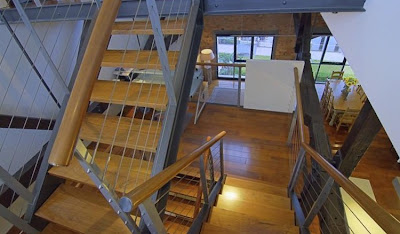Founded in Sydney in 1855, the Colonial Sugar Refining Co (CSR) started to dominate the Australian sugar industry in a time of enormous change in the history of sugar; it fuelled the growth of sugar as a new industry in places with suitable growing conditions i.e Queensland. Technological advances in the refining process transformed sugar from a luxury item to a staple food, at least in western countries.
The Refinery and wharf, 2011, Brisbane
By 1874, Queensland was exporting sugar to the other Australian colonies. CSR moved north and acquired large tracts of land for sugar growing near Mackay. In total CSR established 3 large mills in Nth Queensland where Pacific Islanders comprised the majority of the workforce.
By the 1890s, the plantation system was no longer dominant; the industry increasingly required large companies. CSR needed to concentrate more on the value adding end of the market i.e. milling and refining. CSR's Brisbane refinery was the 4th in a chain of refineries that they established in Australia's capital cities; refineries were opened in Sydney (Pyrmont 1878 Australia’s largest), Melbourne (Yarraville c1875), and Adelaide (Glanville 1891).
The original red face bricks
The 1893 complex consisted of the refinery building comprising char house, cistern house, pan house and refined sugar store; raw sugar store; melt house; boiler house; workshop; a two storied building containing offices, laboratory and hessian rooms; and the wharf. Most of the original machinery was made in Scotland. The char house, by the way, was middle step in the sugar refining process, in between the melting stage and the crystallisation stage.
Built during a time of economic depression, the Brisbane refinery was important in demonstrating the company's dominance of both the Queensland and Australian sugar industry for over a century. This was thanks, one assumes, to the Queensland Government's protectionist trade policies in the decade prior to Federation.
New Farm was already the industrial and warehousing district of Brisbane. But CSR added something new; they successfully lobbied for the building of the Bulimba branch railway (completed 1897). Later development of the area benefited from the availability of both wharfs and rail facilities, and included the woolstores (1909) and the New Farm Power House (1928).
The Refinery’s main building (1893) was a long narrow structure, facing the river. The walls were composed of face bricks laid in English bond, around a combination of timber and cast iron framework. It was four storeys high at the southern end and five storeys at the northern end. Rising above the corrugated iron roof line was a hexagonal shaped tower, originally used for the storage of char.
But nothing stays the same. In 1988, the residence was removed from the site; in 1989 the rail link to the refinery was closed; and CSR totally ceased operations at the New Farm refinery in 1998. The buildings fell into ruination.
Industrial feel to the apartment interiors
Now the exterior of The Refinery has been totally restored; the transformed interior now houses 30 apartments, thus converting a large industrial processing building to a residential use. And saving it. The main 1893 refining building still demonstrates the principal characteristics of a C19th industrial building, including use of fully visible face bricks, restrained embellishment and a narrow, vertical form. Note the char tower with its decorative brackets and finial, the grassed banks, fence, wharf and river. Directly behind the central core is the raw sugar store, flanked by warehouses on the southern side and ancillary buildings.
Internally many modifications have been made, resulting in some alterations to the floor levels, most notably in the char house. The framing in the southern end (refined sugar store and pan house) is timber, whilst that in the northern end (cistern and char house) is of cast iron. The renovated interiors retain this industrial image.
The refinery is now one of the last surviving industrial sites on the inner city reaches of the Brisbane river and one of the last to retain its wharf. So it is important. It had to be saved, and it was!
River frontage
Questions to ask, as a result of this experience:
1. Do important industrial sites deserve heritage protection, like churches and historical homes?
2. If the original industrial architecture was not aesthetically pleasing, can it be tarted up?
3. Should a preservation order cover the industrial building's interiors as well?
4. Do the outbuildings in industrial sites need to be protected?




